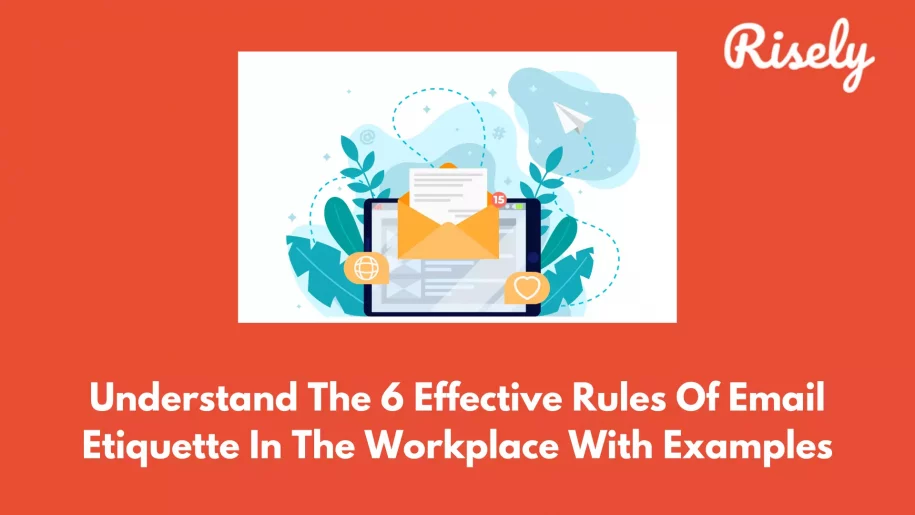Understand The 6 Effective Rules Of Email Etiquette In The Workplace With Examples
Have you ever hit “send” on an email and immediately regretted it? Or received an email that left you scratching your head, wondering if the sender had forgotten their manners? We’ve all been there! Email etiquette is something we often overlook in the fast-paced world of the workplace, but it can make a difference in how we communicate and collaborate with our colleagues. So, let’s dive into the wonderful world of email etiquette and explore how it can revolutionize our professional interactions. In this blog, we’ll uncover the benefits of mastering email etiquette, discover time-saving email templates, and unveil the six basic rules to ensure your emails are always clear, concise, and professional. Get ready to level up your email game!What is Email Etiquette in the Workplace?
Email etiquette in the workplace refers to guidelines and practices governing how emails are composed, sent, and responded to in a professional setting. It encompasses rules for effective communication, appropriate language, formatting, and overall conduct when using email as business communication. Email etiquette at work ensures that emails are clear, respectful, and professional, promoting efficient and harmonious communication among colleagues and stakeholders. Following email etiquette at work can foster professionalism, enhances relationships, and helps avoid misunderstandings and conflicts.Understanding the Importance of Email Etiquette in the Workplace
Email etiquette in the workplace plays a crucial role in maintaining effective communication and professionalism. It is essential because it ensures that emails are clear, concise, and respectful, minimizing the risk of misinterpretation or offense. By following email etiquette, individuals can foster positive relationships, enhance collaboration, and reduce conflicts. Clear and well-structured emails save time, improve productivity, and convey professionalism to recipients. Moreover, practicing email etiquette reflects positively on one’s brand and workplace reputation. Understanding and adhering to email etiquette at work is vital for creating a positive environment and facilitating efficient communication among colleagues and stakeholders.The 6 Effective rules of Email Etiquette at Work
Here are the six effective rules of email etiquette at work, with examples:Rule 1: Be Clear and Concise
Imagine you’re requesting information from a colleague about a project. Instead of composing a lengthy email with unnecessary details, try something like this: “Hey [Colleague’s Name], I hope you’re doing well! I need some information regarding the XYZ project. Can you please provide me with the latest status update, key milestones achieved, and any potential roadblocks we should address? Thanks in advance! Best regards, [Your Name].”Rule 2: Use Professional Language
It’s crucial to maintain a professional tone in your emails. Consider this scenario: you need to give feedback to a team member. Instead of sounding harsh, try a diplomatic approach: “Hi [Team Member], Great job on completing the ABC report! I wanted to share some feedback to help improve future projects. I noticed a few areas where we can enhance the analysis section. Let’s schedule a quick meeting to discuss the changes. Your dedication and efforts are truly appreciated. Best regards, [Your Name].”Rule 3: Choose Appropriate Subject Lines
A captivating subject line can make all the difference. Suppose you’re organizing a team meeting. Instead of a generic subject line like “Meeting,” grab attention with something like this: “Action Required: Team Meeting on XYZ Project – Your Input Needed!”Rule 4: Be Mindful of Tone and Emotions
Written words can be easily misinterpreted, so choosing your words wisely is important. Let’s say you’re discussing a deadline extension. Instead of coming across as demanding, show empathy: “Hello [Recipient], I hope this email finds you well. Due to unforeseen circumstances, I wanted to discuss the possibility of extending the deadline for the project we’re working on. I understand if this may cause inconvenience, but it will help us deliver a better outcome. So let’s connect and find a solution that works for everyone. Warm regards, [Your Name].”Rule 5: Use Proper Formatting
Cluttered and poorly formatted emails can be overwhelming. Instead, consider using bullet points, paragraphs, and headings where necessary to make your message more reader-friendly. For instance, if you’re sharing a project update, structure it like this: “Hi [Recipient], I wanted to provide you with a quick update on the XYZ project:- Milestone 1: Completed on time, and we’ve received positive feedback from the client.
- Milestone 2: We’re currently in progress and on track to meet the deadline.
- Milestone 3: Upcoming tasks include [specific tasks and deadlines].
Rule 6: Proofread Before Sending
Mistakes happen, but taking a moment to proofread your emails can save you from embarrassing typos or incorrect information. Before hitting “send,” double-check your message for errors or inaccuracies. By following these six basic rules of email etiquette at work, you’ll ensure your emails are professional, effective, and respectful. So now go forth and conquer your inbox with confidence!Benefits of having Email Etiquette at Work
Mastering email etiquette at work offers numerous benefits that can positively impact your professional life. Let’s explore some of the key advantages:- Enhanced Professionalism: Email etiquette demonstrates professionalism and respect for colleagues. It reflects positively on your image and reputation in the workplace. You project an image of competence and professionalism by sending well-crafted and courteous emails.
- Improved Communication: Following email etiquette ensures clear and concise communication. When your emails are well-structured, polite, and concise, it becomes easier for recipients to understand your message and respond appropriately. This leads to efficient and effective communication within teams and across departments.
- Increased Productivity: Email etiquette can significantly boost productivity. By being clear in your emails, you reduce the chances of misunderstandings or the need for multiple follow-up messages. This saves time and lets you and your colleagues focus on the tasks.
- Strengthened Professional Relationships: When you communicate respectfully and professionally, you foster positive relationships with your colleagues. This can improve collaboration, teamwork, and a more harmonious work environment. People appreciate receiving well-written and thoughtful emails, and it can contribute to building strong professional connections.
- Reduced Conflict and Misunderstandings: Email etiquette helps minimize workplace conflicts and misunderstandings. Choosing your words carefully, being mindful of tone, and avoiding ambiguous statements can prevent potential conflicts and maintain a harmonious work atmosphere.
- Enhanced Personal Branding: Your email communication reflects your brand. Adhering to email etiquette establishes yourself as a reliable, professional, and competent individual. This can positively impact your career progression, as others perceive you as someone who pays attention to detail and possesses effective communication skills.
Conclusion
By incorporating the six effective rules of email etiquette in the workplace and embracing the benefits, you’re well on your way to being a master communicator. Remember, clear and respectful emails enhance productivity and better colleague relationships. Now it’s time to put your knowledge into action. Start implementing these etiquette guidelines in your everyday email communication. And if you’re looking to enhance your managerial skills further, check out Risely, the AI-powered manager coaching platform. It’s a fantastic resource to level up your leadership abilities. So go ahead, confidently conquer your inbox, and watch how email etiquette transforms your professional interactions.Whether written or spoken, communication is the key to your growth. Have you mastered it?
Find out now with the communication skills assessment for managers and leaders who are unlocking success.
FAQs
What are the five rules of email etiquette?
The five email etiquette rules include being clear and concise, using a professional tone, choosing an appropriate subject line, proofreading before sending and respecting others’ time and privacy.
What is the proper email etiquette?
Proper email etiquette includes being clear and concise, using professional language, having a meaningful subject line, proofreading for errors, and respecting recipients’ time and privacy.
How do you use email effectively in the workplace?
Use email effectively in the workplace, be clear and concise, use professional language, organize emails with clear subject lines, respond promptly, and respect privacy and confidentiality
Other Related Blogs
Talking Internal Career Mobility with Dr. Edie Goldberg
Talking Internal Career Mobility with Dr. Edie Goldberg What do employees want? As per the LinkedIn Learning Report, the answer seems to be professional growth. Employees are willing to undergo…
Leadership Gaps: Identifying and Filling the Loopholes as a Manager
Leadership Gaps: Identifying and Filling the Loopholes as a Manager As a manager, you strive to create a cohesive team that works together to achieve common goals. However, sometimes, you…
6 Ways to Employee Career Development that Managers Love
6 Ways to Employee Career Development that Managers Love When it comes to career development, managers need to understand their team’s needs and help support the team’s career development. It…
5 Reasons To Try Executive Coaching For Leaders
5 Reasons To Try Executive Coaching For Leaders Leadership development is a hot topic and executive coaching also seems to be an emerging trend. A thousand mediums available to grow…


